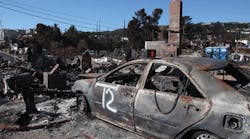California Regulators Want to Fine PG&E $1.4 Billion for Fatal Pipeline Blast
A 2010 pipeline blast that killed eight people and destroyed 38 homes in San Bruno, Calif., could carry a massive price tag for Pacific Gas and Electric Co.
The California Public Utilities Commission earlier this week ruled that the utility company should pay a $1.4 billion fine, the commission’s largest-ever safety-related penalty.
Two administrative law judges found that PG&E committed 3,798 violations of state and federal regulations and standards covering the operation of its natural gas pipeline. The judges concluded that many of the violations continued for several years, resulting in more than 18 million days in violation.
Factoring in a previous ruling in which the commission ordered PG&E shareholders to pay $635 million for safety improvements to the pipeline, PG&E is facing more than $2 billion in penalties.
The commission’s $1.4 billion penalty, which is not final, would include $950 million to be paid to California’s General Fund; $400 million in pipeline improvements (the cost of which cannot be passed on to customers); and approximately $50 million for pipeline safety measures. The latter figure includes $30 million for the commission’s Safety and Enforcement Division to hire independent auditors, conduct emergency training and establish a centralized database to track location and use of salvaged pipe in PG&E’s gas pipeline.
The decisions of the administrative law judges will become final after 30 calendar days from Sept. 2, unless PG&E files an appeal or a commissioner requests a review.
While the commission estimated that the sum of PG&E’s penalties are more than $2 billion, PG&E asserted that the total financial impact could reach $4.75 billion, factoring in the costs of improving its natural gas operations.
In a statement, PG&E Chairman and CEO Tony Earley said the company has “respectfully asked that the commission ensure that the penalty is reasonable and proportionate and takes into consideration the company's investments and actions to promote safety.”
“We've worked hard to do the right thing for the victims, their families and the community of San Bruno,” Earley said. “Beyond this, all of us at PG&E have committed ourselves to a goal to transform this company into the safest and most reliable energy provider in America. We’ve hired some of the best gas experts in the country to help guide this effort and supported it with billions of dollars in shareholder funding.
“We have made tremendous progress but we’re not done. We have more work to do and we won’t rest until it’s done and done right.”
In the wake of the pipeline explosion, PG&E said 3,500 company leaders have received safety training, and the company has installed new pipe, emergency shutoff valves and gas-leak-detection technology, among other safety measures.
The company said it has paid more than $500 million to the victims and their families, and has contributed $70 million to support the city of San Bruno’s recovery efforts.
Until the Sept. 2 ruling, the commission’s largest safety-related penalty was $38 million, levied against PG&E after a 2008 natural gas explosion in Rancho Cordova, Calif.
